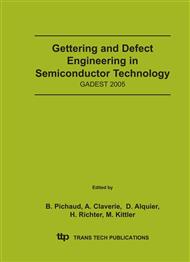p.291
p.297
p.303
p.309
p.315
p.321
p.327
p.333
p.339
Bulk Radiation Damage Induced in Thin Epitaxial Silicon Detectors by 24 GeV Protons
Abstract:
Radiation hardness of silicon detectors based on thin epitaxial layer for the LHC upgrade was studied. No type inversion was observed after irradiation by 24 GeV protons in the fluence range (1.5–10)⋅1015 cm–2 due to overcompensating donor generation. After long-term annealing highly irradiated devices show decrease of effective doping concentration and then undergo type inversion. All mentioned means that thin epitaxial devices might be used for innermost layers of vertex detectors and need moderate cooling during beam off time. Properly chosen scenario might help to restore their working characteristics.
Info:
Periodical:
Pages:
315-320
Citation:
Online since:
December 2005
Keywords:
Price:
Сopyright:
© 2005 Trans Tech Publications Ltd. All Rights Reserved
Share:
Citation:


